Soil
gary.maguireSoil and potting mix
Contact: Gary Chastagner, 253-445-4528 | WSU Puyallup Research & Extension Center, 2606 West Pioneer, Puyallup, WA, 98371-4998 USA
Last updated January 2, 2013
Contact: Gary Chastagner, 253-445-4528 | WSU Puyallup Research & Extension Center, 2606 West Pioneer, Puyallup, WA, 98371-4998 USA
Last updated January 2, 2013
Plant Pathogen
Phytophthora ramorum is a microscopic organism that has evolved to parasitize plants. It is a particularly harmful plant pathogen because it can kill many of the species it can infect (hosts).
Biosecurity
Phytophthora ramorum is a global concern because it can infect many different plant species and spread relatively quickly. Unfortunately, it is challenge to manage because of its broad host range, long-term survival, and the variation in symptoms associated with infections. Furthermore, sometimes management practices (fungicides, biostimulants, etc.) can suppress the expression of symptoms, possibly resulting in the movement of an asymptomatic, but infected, plant.
More Information
More information about Phytophthora species and P. ramorum is available here.
General Information
Sudden Oak Death is a disease caused by Phytophthora ramorum. You can find more information about Sudden Oak Death at the links below:
Currently there are 5 tree species native to western North America that can be killed when they are infected with Phytophthora ramorum. These are tanoak (Lithocarpus densiflorus) and four oak species – Coast live oak (Quercus agrifolia), Canyon live oak (Q. chrysolepis), California black oak (Q. kelloggii), and Shreve oak (Q. parvula var. shrevei).
In Europe, P. ramorum has been found to cause stem cankers leading to death of European beech (Fagus sylvatica), European sycamore (Acer pseudoplatanus), Horse chestnut (Aesculus hippocastanum), Northern red oak (Q. rubra), Sessile oak (Q. petraea), Southern beech (Nothofagus obliqua), Southern red oak (Q. falcata), and Turkey oak (Q. cerris). None of these tree species are native to Washington State, although they can be found planted as ornamentals.
There are many diseases and pests that produce symptoms similar to those of Sudden Oak Death. This guide will help you to rule out SOD by identifying some of the more commonly encountered pest problems. In addition, it will help determine whether the plant is potentially infected with P. ramorum and the need for a sample to be collected.
Some tree diseases that produce symptoms similar to P. ramorum are the following:
Phytophthora ramorum produces leaf blotches, twig cankers, and shoot die-back on many plants. In some cases the shoot dieback may be severe enough to kill the plants (e.g., huckleberry and madrone), but in general they do not usually die as a result of P. ramorum infection. These are the most common hosts in Washington State.
USDA Animal and Plant Health Inspection Service (APHIS)
California Oak Mortality Task Force (COMTF)
Forest Research (United Kingdom)
Forest Phytophthoras of the World
Visit our Sample Submissions Guidelines webpage for information to help determine whether it will be helpful to submit a plant sample for professional diagnostics.
The WSU Plant Clinic can provide diagnostic services to identify the cause of symptoms on Rhododendrons and other plant species.
Click here to read their instructions for submitting a sample.
Have more questions or concerns?
Contact us for more information or to schedule a site visit and Critical Control Point (CCP) Assessment. Fill out the webform on the right and we will reply shortly after.

WSU Puyallup Research & Extension Center, 2606 West Pioneer, Puyallup, WA, 98371-4998 USA
Home | Contact Us | Jobs | Citizen Science | Our Community | Support Our Program
| Use new containers for high risk host plant material to prevent contamination of plants from potting media and plant debris that may contain pathogens. | 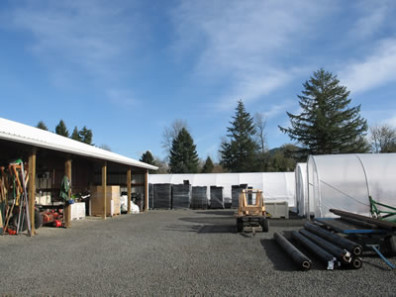 |
| Store used containers that previously had host material separately from those planned for re-use. | 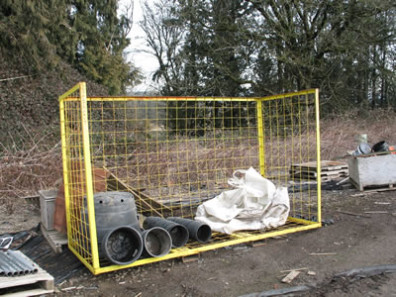 |
| Used containers from host and high risk plants should be recycled if they are not going to be sanitized. Re-using these containers introduces the risk of infection from residual soil and potting media containing disease inoculum. | 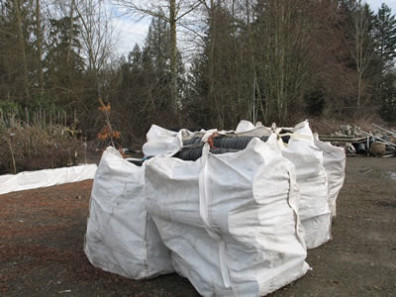 |
| Used pots can be steam sterilized for re-use. This steam cabinet was constructed from materials available at most hardware stores and can be scaled to any size needed.The length of exposure to steam depends on the number of pots being sterilized. | 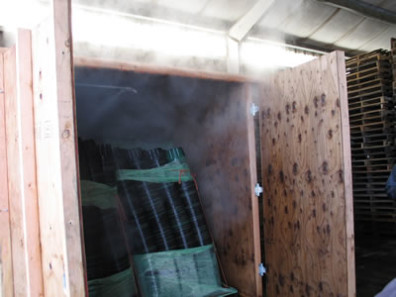 |
| A hot water bath is used to sanitize small containers. Pots are stacked inside the plastic bin, which is lowered into the hot water bath and held for several minutes. Length of time in the bath depends on the number of pots being sanitized. | 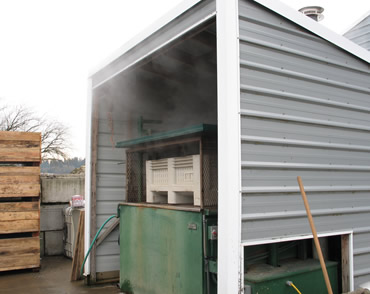 Back to Managing Phytophthora diseases in the nursery Back to Managing Phytophthora diseases in the nursery |
Contact: Gary Chastagner, 253-445-4528 | WSU Puyallup Research & Extension Center, 2606 West Pioneer, Puyallup, WA, 98371-4998 USA
Last updated January 2, 2013
 Many of the plants that are grown in the PNW forest and native plant nurseries are hosts for P. ramorum. In addition to the economic impact that nurseries would suffer if P. ramorum was to be detected, the movement of infected plant material from these nurseries would likely result in the introduction of the pathogen into forest or natural sites. This may have significant economic and/or ecological impacts.
Many of the plants that are grown in the PNW forest and native plant nurseries are hosts for P. ramorum. In addition to the economic impact that nurseries would suffer if P. ramorum was to be detected, the movement of infected plant material from these nurseries would likely result in the introduction of the pathogen into forest or natural sites. This may have significant economic and/or ecological impacts.
There are a number of phytosanitary measures that native plant nurseries can take to minimize the risk of inadvertently introducing P. ramorum or other Phytophthoras into a nursery site. Given the continued spread of P. ramorum inoculum from ornamental nurseries into nearby waterways, one of the keys is to treat any water that is used from streams or lakes for irrigation.
Another key is to be very careful about the plant material that is brought into the nursery and inspect new shipments closely for symptoms, especially if they are coming from an area where P. ramorum is established.
Native plants used in restoration sites are at risk for spreading P. ramorum into forests if they are infected. It is important to be aware of the source of irrigation water for these plantings.
Phytophthora and other diseases can spread in residual soil and plant material in pots that are re-used. Pots can be treated with disinfectants or heat to kill these organisms.
California Society for Ecological Restoration Quarterly Newsletter Summer Volume 26, Issue 2 has these two articles:
“Nursery Plants as a Pathway for Plant Pathogen Invasion” by Susan J. Frankel, Kathy Kosta, and Karen Suslow
“Solarization: A Simple and Low-Cost Method for Disinfesting Horticultural Containers” by Karen Suslow and Kathy Kosta
A Phytophthora tentaculata Pest Alert is now available. P. tentaculata is an emerging pathogen in California native plant nurseries and restoration plantings.
So far, P. ramorum has not escaped into the natural environment in the PNW except for in streams associated with positive nurseries and landscapes. Research on the amount of inoculum needed in water for infection, susceptibility and sporulation potential of plant hosts, and other topics will help us determine the level of risk to our forests. In the meantime, it pays to be cautious when working with host plants.
Photos of native plant nursery best (and worst) management practices
If you have ideas or photos to add to these pages, let Marianne know.
Thanks to Regina Johnson for many of the photos used in this section.
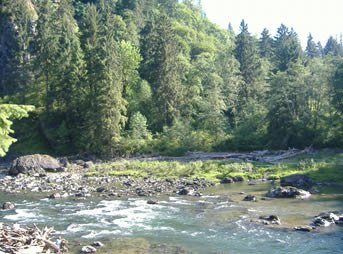 A laboratory study using detached leaves of some common broadleaf hosts found in the PNW was undertaken in summer of 2009 and 2010. Leaves were inoculated with a zoospore suspension of an NA1 isolate of P. ramorum and lesion area and infection frequency was evaluated. If P. ramorum was recovered from a leaf that did not show a visible lesion, it was considered to be infected asymptomatically. Sporulation potential of foliage of each plant species was also determined.
A laboratory study using detached leaves of some common broadleaf hosts found in the PNW was undertaken in summer of 2009 and 2010. Leaves were inoculated with a zoospore suspension of an NA1 isolate of P. ramorum and lesion area and infection frequency was evaluated. If P. ramorum was recovered from a leaf that did not show a visible lesion, it was considered to be infected asymptomatically. Sporulation potential of foliage of each plant species was also determined.
In general, the results of this study indicate that western Washington forests are not at high risk for damage caused by P. ramorum, based on the host plants tested. However, this is a subset of the many plant species that occur, and there may be a host species that is either extremely susceptible to infection or a prolific sporulator, that was not tested in this study. Plants posing the smallest risk of P. ramorum establishment were generally invasives and/or riparian species. The highest risk plants were commonly found in forested environments. These were fairly susceptible to infection and produced more chlamydospores than sporangia in their foliage.
Chlamydospore production was higher than sporangia production on many hosts in western Washington forests that were examined in this study. In other systems, such as bay laurel (Umbellularia californica) in California, and Rhododendron ponticum in the UK, P. ramorum outbreaks are driven by high concentrations of sporangia produced on foliage of these hosts. None of the Washington hosts tested produced as many sporangia as U. californica. Chlamydospores are a means by which P. ramorum can persist on a site in soil and decaying foliage, but will probably not produce large amounts of inoculum unless they germinate directly into sporangia, which can occur in flooded soils.
Back to Native Plants
Contact: Gary Chastagner, 253-445-4528 | WSU Puyallup Research & Extension Center, 2606 West Pioneer, Puyallup, WA, 98371-4998 USA
Last updated January 2, 2013